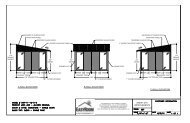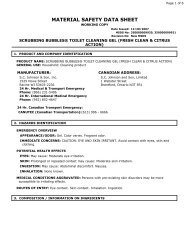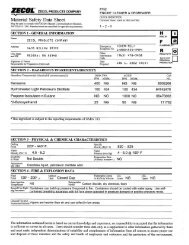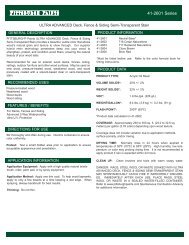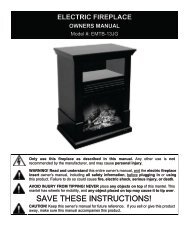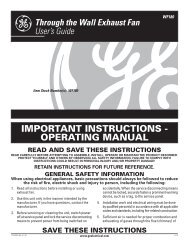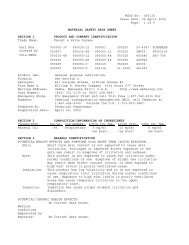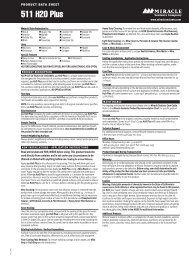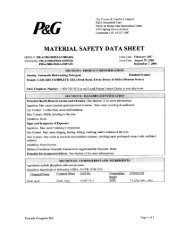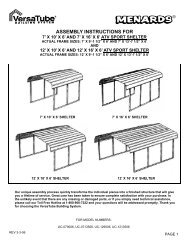10" 15 AMP COMPOUND MITER SAW - Menards
10" 15 AMP COMPOUND MITER SAW - Menards
10" 15 AMP COMPOUND MITER SAW - Menards
Create successful ePaper yourself
Turn your PDF publications into a flip-book with our unique Google optimized e-Paper software.
6<br />
OPERATING PROCEDURES<br />
5. To begin cutting, lower the cutting head. The movable guard opens automatically.<br />
6. After cutting, allow the head to come back up. The guard will close automatically.<br />
7. The saw will stop when you release the trigger switch in the handle.<br />
MODES OF USE<br />
Chop cut:<br />
The head is locked in the upright position. The table rotation is locked at 0°.<br />
This is a good setting for simple 90° crosscuts.<br />
Miter cut:<br />
The head is locked in the upright position. To unlock the table rotation, unscrew the<br />
locking handle and press on the miter detent spring lever<br />
with your thumb. Move the table rotation to the left or right up to 45° left & 45° right.<br />
The miter detent spring lever , if released, will stop the table at detents<br />
at 0°, <strong>15</strong>°, 22.5°, 30°, & 45° left and right. Use the locking handle to<br />
lock the table at the desired angle, especially those between the detents.<br />
Bevel cut:<br />
To unlock the head angle (bevel) adjustment, loosen the bevel lock handle<br />
at rear of the saw. Lock it when the blade is tilted at the desired angle.<br />
The table rotation is locked at 0°.<br />
Compound cut:<br />
Unlock and move the table rotation to the left or right as in miter cuts above. Using<br />
the lever at the back of the saw, unlock the head and bevel it to any position from<br />
0° – 45° left, then lock it in place.<br />
NOTE: At extreme positions, the hold-down clamp should be moved to the right<br />
side of the table to prevent interfering with the movement of the cutting head.<br />
Always check before making the cut if there is any potential interference from the<br />
clamp or any other part of the machine.<br />
MAINTENANCE<br />
NOTE: Even<br />
though the angles are marked on the machine, it is always a good<br />
idea to check them by making a trial cut. See Aligning Miter and Bevel, below.<br />
Inspect the cord regularly and have it replaced by an authorized repair facility if<br />
it is damaged.<br />
Check the brushes occasionally (after about 50 hours of use) and replace if<br />
worn. The brushes can be replaced by removing the motor back cap.<br />
The brushes and their springs could jump out of the holders- be careful<br />
not to lose them. Inspect the brushes. If the contact surface is not<br />
smooth, or it is worn or heavily used, replace both brushes. Insert the new<br />
brushes and springs in their holders and re-fasten the cap.<br />
The plastic kerf plate table insert should be replaced if damaged to reduce the<br />
risk of chips lodging in the slot and catching in the blade.<br />
Keep the vents clear of dust and debris. This will help prevent possible electrical<br />
shorts and ensure proper cooling.<br />
Keep the tool housing and handle clean and free of oil and grease by using mild<br />
soap and a damp (not wet) cloth.



